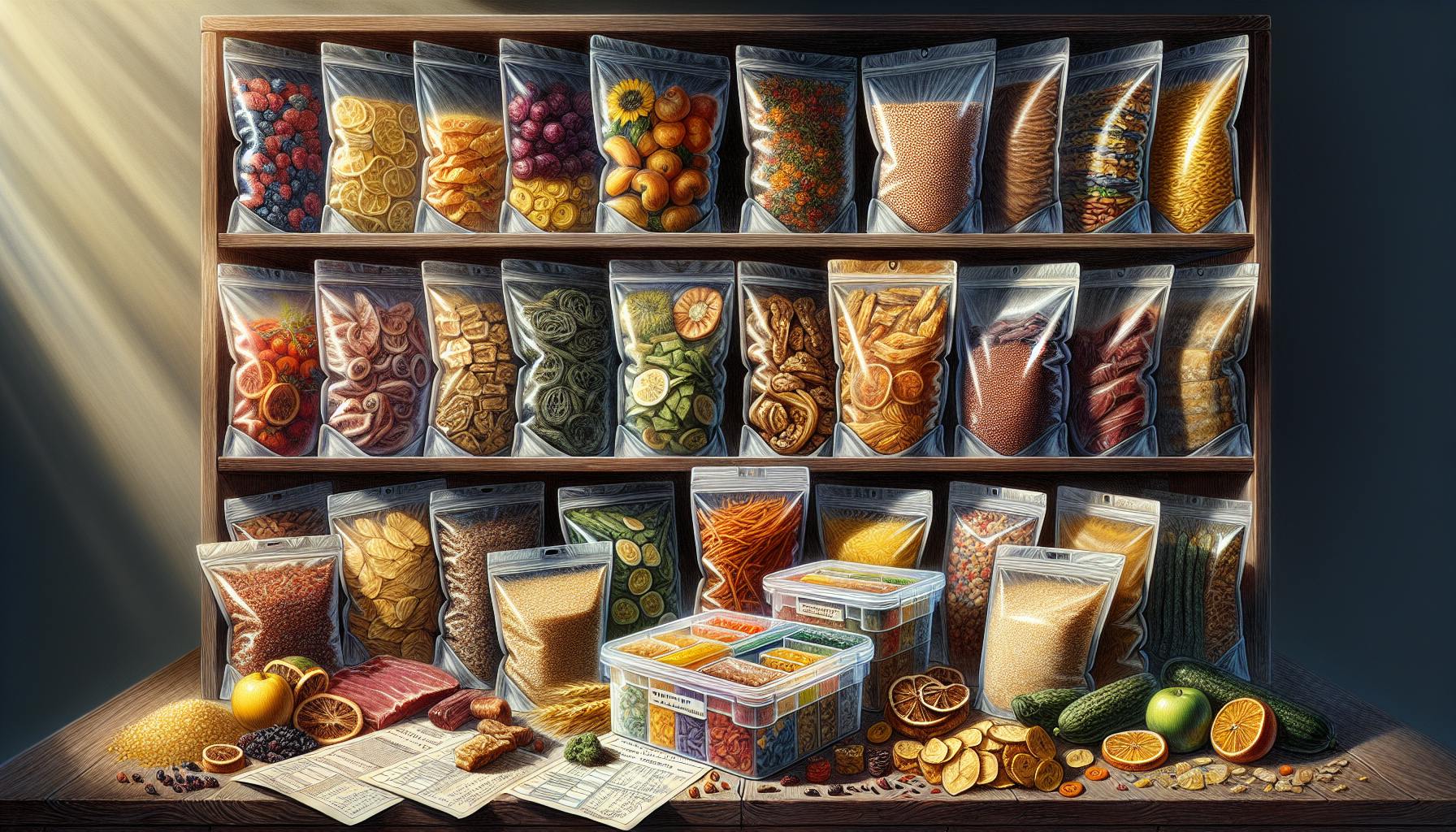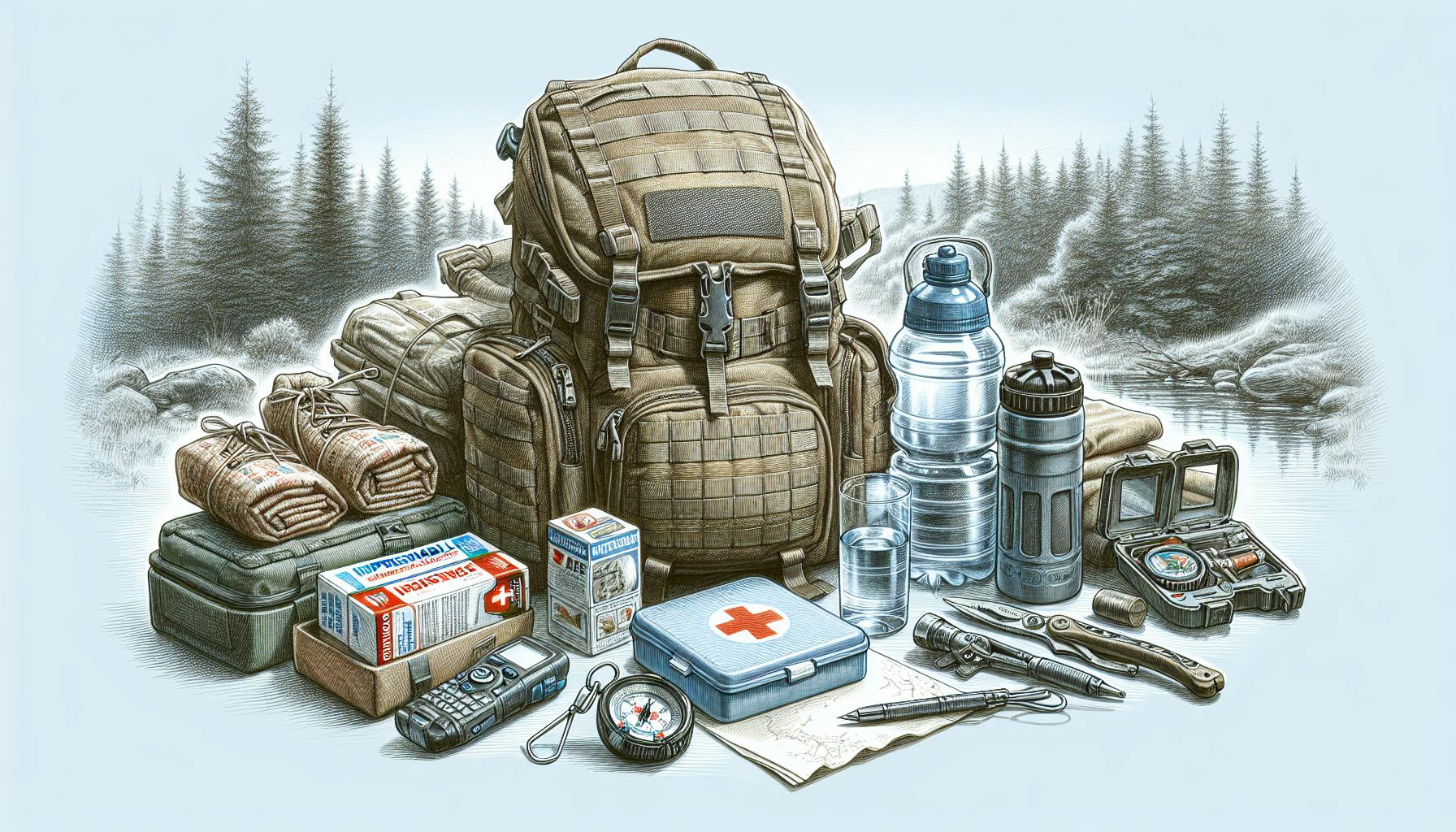When crisis strikes, having an evacuation kit ready can make all the difference for a safe and efficient exit.
This comprehensive guide outlines the most critical items to include in your grab-and-go evacuation bag so you're fully prepared when seconds count.
You'll discover the top 10 essentials no kit should be without, key non-food items for survival and navigation, and specialized considerations to meet your specific evacuation scenario needs.
Introduction
This comprehensive guide outlines the top prepper items to include in an evacuation kit. It serves as a prepper supplies list for those seeking to be prepared for any emergency that necessitates a swift departure.
Understanding the Purpose of an Evacuation Kit
An evacuation kit, sometimes called a "bug out bag", is designed to contain critical supplies needed to survive for at least 72 hours when evacuating from a disaster or emergency scenario. Key reasons to have an evacuation kit prepared include:
- Allows for quick departure without wasting precious time gathering supplies
- Provides basic necessities if temporary shelter, food, water is needed
- Can make a difference between life and death in a disaster scenario
- Grants peace of mind knowing you have a plan for emergency evacuation
The exact contents of the kit can be customized, but should include non-perishable food, water, first aid supplies, flashlights, battery packs, and other gear for self-reliance in an emergency.
The Prepper List 2023: Essentials for Modern Challenges
When assembling an evacuation kit in 2023, some key factors to consider include:
- Portability - Many disasters may require evacuating on foot, so light, compact items in a backpack work best
- Power banks - With reliance on mobile devices, backup power is essential
- Water filtration - Modern water filters allow for finding and purifying water
- Weather appropriate gear - Consider regional risks like extreme heat or cold
- Navigation tools - GPS devices, maps, compasses to find your way
Focusing your 2023 prepper list on versatile, tech-enabled gear provides preparedness for a wide range of modern scenarios.
The Importance of Non-Food Prepper Items
While food is critical, an evacuation kit should focus heavily on other supplies like:
- First aid - Injury treatment essentials like bandages, ointments, medicines
- Lighting - Flashlights, headlamps, glow sticks to navigate in darkness
- Tools - Knives, paracord, duct tape, multi-tool for survival needs
- Fire making - Matches, lighters, fire starters enable warmth, signaling
- Shelter - Tents, tarps, emergency blankets and bivvy sacks
- Clothing - Extra socks, jackets, hats for variable weather conditions
Prioritizing these non-food items makes your evacuation readiness more robust.
Best Prepper Items on Amazon: Convenient Shopping for Your Kit
Top recommended evacuation kit products readily available on Amazon include:
- Wise Food 5-Day Emergency Food Supply
- LifeStraw Personal Water Filter for Hiking
- Gear Aid ARC Rechargeable Headlamp
- Surviveware Small First Aid Kit
- J5 Tactical Flashlight
- Lodge Cast Iron Skillet
Amazon's wide range, Prime shipping, ratings and reviews help conveniently build a reliable, affordable kit.
Planning for Different Scenarios: Tailoring Your Kit
Consider building multiple evacuation kits or customizing with scenario-specific additions like:
Earthquake Preparedness:
- Dust masks, goggles for airborne particles
- Fire extinguisher for structure fires
- Cash in small bills
Cold Weather Evacuation:
- Hand warmers, wool socks
- Insulated, waterproof boots
- Heavy snow gear like parkas, gloves
This allows your evacuation plan flexibility for location and season-specific hazards.
Top 10 Essential Prepper Items for Your Evacuation Kit
Identifying key supplies to include in an evacuation go-bag can help ensure you have critical tools and resources if disaster strikes. Focusing on versatile, durable, and practical items will enable preparedness for a wide range of situations.
Water Filtration and Purification Systems
Having methods to filter and disinfect found water sources makes water purification possible without electricity or plumbing. Portable water filters remove bacteria, parasites, and sediment. Chemical disinfection with chlorine dioxide tablets can further protect against viruses when boiling is not possible. Combining multiple methods helps ensure safe drinking water from lakes, streams, etc. Recommended items include:
- LifeStraw personal water filter
- Sawyer MINI water filter
- Potable Aqua chlorine dioxide tablets
- Collapsible water containers and bottles
Reliable Fire Starting Tools
Generating warmth and heat for cooking requires ignition methods unaffected by weather. Focus on diverse fire starters spanning matches, lighters, flint rods, and tinder sources. Storing tools in waterproof containers enables reliability. Recommended items include:
- Waterproof match cases with strike-anywhere matches
- Refillable butane lighters
- Magnesium alloy fire starter rods
- Tinder sources like dryer lint, wax-soaked cotton balls, etc.
Versatile Multi-Tools
Equipping evacuation bags with multi-tools like Swiss Army Knives or Leatherman implements enables handling a wide range of survival tasks. Look for options with pliers, screwdrivers, can openers, scissors, knives, and other attachments. Rugged, corrosion-resistant stainless steel builds stand up to heavy use.
Communication Devices: Emergency Radios
Maintaining access to news and emergency broadcasts during disasters requires self-powered radios. Hand crank and/or solar-charged designs allow power generation when batteries die. Choose AM/FM models with phone chargers, flashlights, and alarm clocks for versatility. Waterproof designs add resilience.
Emergency Cash Reserves
Cash enables procuring supplies or services when electronic transactions fail. Smaller denominations stretch limited funds further. Store bills in a waterproof cash stash can, survival tin, or zip-close bag to protect paper money from water damage during floods or storms.
sbb-itb-b932644
Non-Food Items Crucial for Evacuation Preparedness
A focused guide on non-food prepper items that are essential for any evacuation scenario.
Navigational Tools for Safe Travel
Having the right navigational tools like maps, compasses, and GPS devices can mean the difference between life and death when evacuating an area. Here are some of the top options to consider:
-
Maps - Laminated state maps with detailed topography are vital. You'll want to highlight evacuation routes ahead of time. Road atlases are also useful.
-
Compass - A quality compass like a Suunto or Silva can help you navigate if you become lost or disoriented. Make sure to learn proper usage before an emergency.
-
GPS Device - Handheld GPS units from Garmin or other brands are extremely helpful for navigation. Just be sure to pack extra batteries.
-
Personal Locator Beacons - PLBs with GPS can alert emergency responders to your location if in dire distress. The ResQLink View is a top choice.
Having multiple navigation tool options in your evacuation kit provides redundancy in case one fails.
Personal Protection and Safety Gear
Protecting yourself from environmental hazards during an evacuation is crucial. Here are important items to include:
-
Dust Masks - N95 particulate masks filter out hazardous debris in the air.
-
Safety Goggles - Shatter-resistant goggles prevent eye injuries. Look for padded, flexible options.
-
Work Gloves - Durable leather/canvas gloves shield hands from debris and cuts.
-
Hiking Boots - Waterproof boots with ankle support and rugged soles provide protection and traction on uneven terrain during long treks.
-
Emergency Whistle - A loud whistle like the Storm All Weather Whistle can signal rescuers if needed.
-
Two-Way Radios - Long range two-way radios keep your family or group connected if cell towers are down. The Motorola T800 is a top-rated option.
Shelter and Warmth: Tents, Sleeping Bags, and Insulation
Having portable shelter and insulation is vital when evacuating quickly. Here are must-have items:
-
Compact Tent - A durable, lightweight backpacking tent provides critical shelter. The ALPS Mountaineering Lynx 1-Person Tent is a great choice.
-
Sleeping Bags - Warm mummy-style sleeping bags like the TETON Sports Celsius XL keep you insulated in frigid temps.
-
Emergency Bivvy - A bivvy sack like the SOL Emergency Bivvy provides backup shelter and retains body heat. It weighs almost nothing.
-
Hand/Foot Warmers - Air-activated warmers can provide critical warmth. A 40-pack of HotHands lasts 10+ hours per pack.
-
Emergency Blanket - Foil emergency blankets retain 80% of body heat and fold up tiny.
Having multiple shelter and insulation items prevents hypothermia which can quickly set in during evacuations.
Hygiene and Sanitation Supplies
Maintaining basic hygiene and sanitation prevents illness when evacuating. Be sure to pack:
-
Sanitation Wipes - Antibacterial wipes like Wet Ones can disinfect hands and surfaces.
-
Toothbrush/Toothpaste - Dental hygiene is critical. Disposable toothbrushes make packing easier.
-
Quick-Dry Towels - PackTowls take up little space and prevent bacteria growth from wet towels.
-
Trowel/Shovel - For proper waste disposal. The Redfora Lightweight Trowel is a great portable option.
-
Heavy Duty Garbage Bags - Essential for containing waste or water collection. 55-gallon contractor bags are very durable.
Proper sanitation and hygiene prevents the spread of illness in confined evacuation quarters.
Illumination and Power: Flashlights and Backup Batteries
Having reliable lighting and power ensures safety when evacuating at night or to dark temporary shelters. Key items include:
-
LED Flashlights - Choose waterproof, impact-resistant LED flashlights with at least 300+ lumens like the Streamlight PolyTac X USB.
-
Headlamps - Hands-free LED headlamps allow you to hike at night or set up camp after dark. The Black Diamond ReVolt is a top choice.
-
Extra Batteries - Pack at least two extra sets of batteries per device. Lithium batteries have a 10-year shelf life.
-
Power Bank - Portable USB power banks like the Anker PowerCore 20K can charge cell phones if the power is out.
Reliable lighting prevents injuries at night. Backup power allows communication with emergency services. Both are critical evacuation prepper items.
Special Considerations for Evacuation Scenarios
Tailoring your evacuation kit with specialized gear for different types of evacuation plans can help ensure you have what you need no matter the situation. Here are some key considerations:
Essentials for Vehicle-Based Evacuation
If evacuating by vehicle, be sure to pack:
- Maps and GPS/navigation apps loaded on your phone
- Emergency car kit with jumper cables, flares, tire repair kit
- Extra fuel or charger for electric vehicles
- Snacks and water
- Pillows, blankets and change of clothes
On Foot Evacuation: Choosing the Right Gear
For evacuating on foot, focus on lightweight, durable gear:
- Sturdy, broken-in hiking shoes/boots
- Lightweight backpack for easy carrying
- Water filtration/purification supplies
- High-calorie, non-perishable food items
- Weather-appropriate clothes and blankets
Family and Group Evacuation Dynamics
When evacuating with others:
- Have a rally point in case you get separated
- Pack activities/games for kids
- Bring copies of key documents for everyone
- Assign tasks so everyone contributes
Pet Evacuation Kit Essentials
Don't forget pet supplies:
- Collar with ID tag, harness/leash
- Pet food, treats and bowls
- Litter box and litter, plastic bags
- Medications, vaccination paperwork
Maintaining Morale: Comfort Items and Entertainment
Boost mental wellbeing with:
- Favorite book, game, or hobby item
- Photos, spiritual items, sentimental small objects
- Notebook, pen, deck of cards
- Battery pack and cords for phones/devices
Tailoring evacuation kits for specific scenarios ensures you have what you need no matter the situation. Prioritize durable, portable gear plus items for health, safety and comfort.
Final Thoughts on Building Your Evacuation Kit
Creating an effective evacuation kit requires forethought and preparation. By keeping the essentials organized and easily accessible, you empower yourself to handle emergencies decisively.
Recap of the Prepper Top 10 List
When compiling your evacuation kit, be sure to include:
- Water and non-perishable food
- First aid supplies
- Flashlights and batteries
- Multi-tool or pocket knife
- Emergency blankets and warm layers
- Cash
- Prescriptions
- Personal hygiene items
- Battery pack and chargers
- Paper maps
Regularly reviewing and replacing expired or damaged gear ensures your kit remains evacuation-ready.
Regular Review and Maintenance of Your Kit
Inspect your kit every 6 months. Check expiration dates, test electronics, and replace low batteries, food, water, and medical supplies. An up-to-date kit avoids nasty surprises when you need it most.
Practical Training and Familiarity with Your Gear
Hands-on practice installing tents, starting camp stoves, administering first aid, reading maps, etc. embeds vital muscle memory. When stressful situations arise, your body automatically recalls the actions needed to deploy your gear effectively.
The Role of Community and Shared Preparedness
Connect with like-minded neighbors to share knowledge, resources, and training. Brainstorm evacuation routes and meeting points. Unity and cooperation enhance safety for all during crises.
Preparedness takes foresight and vigilance. An organized, maintained evacuation kit enables rapid response so you can focus on what matters most - the safety of yourself and loved ones.


